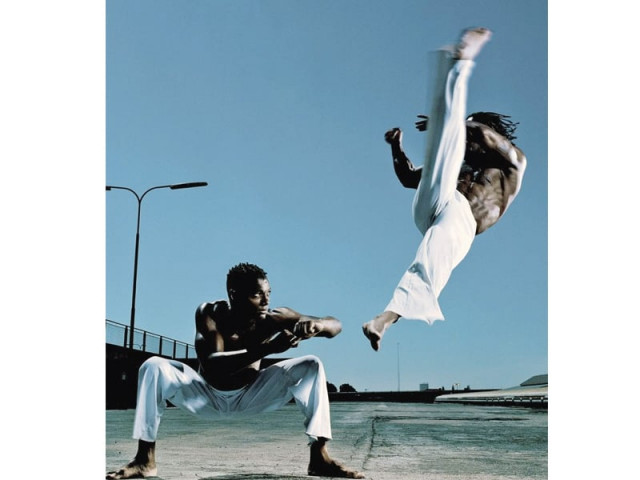Capoeira calling
A Brazilian dance and martial art technique has made its way to Pakistan.

“It’s not ballet,” says instructor Ammar Latif to one of his students, who overextended on one of his kicks. He then crouches low, swivels, and demonstrates the appropriate movement — a whirlwind of taut limbs rising from the ground.
From a distance, this resembles a dance class — an introduction to break-dancing. Upon closer scrutiny, we realise that the group assembled in Islamabad’s Kuch Khaas (a centre for arts and culture) garden is actually practicing a branch of martial arts by the name of Capoeira, a merging of martial arts, self-defence, dance and music.
It’s interesting to note that this Brazilian practice — originating from the slave-diasporas of the 16th century — has made its way to Pakistan. The two nations couldn’t be more geographically and culturally apart; yet there are hints of growing interest. For 25-year old Capoeira student Obaidur Rehman, a popular video-game reeled him in: “I used to play a lot of Tekken and I got really inspired when I saw Eddy [a major Tekken character whose fighting moves are based on Capoeria]. This is my sixth week and I think it’s a great workout and really good for flexibility.”
Incidentally, Rehman used to be a drug addict before he took up Capoeira, which dramatically transformed his life for the better. Watching Latif and his troop perform, it makes sense that there’s really no room for addiction when it comes to the dance; that a healthy mind and body are essential to learning the craft and learning it well. There’s also an element of deception to Capoeira — so much of it involves tricking and evading the opponent — that requires students to hold on to their wits.
In addition, a well-coordinated body is key — with so many of the moves typified by evasive tactics, side-ways motion, aerial acrobatics, power kicks, and plenty of extensive groundwork, explains Latif, 32; a Capoeira veteran. The Express Tribune met up with an energised Latif after the class.
Background
I started in Dublin, essentially. A Brazilian fellow introduced me to it. I used to break dance and did a lot of martial arts before I started looking around for Capoeira. It took me two-and-a-half-years but in 2001, I finally found a school.”
The appeal
“Absolutely everything and especially the cultural side. Capoeira’s a very extroverted martial art: it merges music, dance, and defence — you get so much awareness from it.”
The philosophy
“It’s based on evasion. A lot of the basic movements are very natural, crouched down, and easily evasive. The kicks are shared with all the other martial arts. The basic sideways movement — the essence of the movement and philosophy — is called Ginga. It means to ‘sway,’ to move ‘side to side.’ In fact, if you can just do the Ginga part really well (and nothing else) you’ll still be accepted in Capoeira circles. It allows you to be flexible and unpredictable.”
Peace
“Ultimately, when it comes down to it, you don’t want to get involved in a street fight, or fight aggressively in general. That’s now what Capoeira is about. Street fighting is dirty; it is the antithesis of Capoeira. We have a saying, ‘the best thing to do is to not actually fight.’
Islamabad
“I’m not aiming for this to be a massive success. The culture here isn’t developed enough for Capoeira; people aren’t that into collective sports and too many Pakistanis are also insecure about their bodies. My vision is to get this going is by visiting kachi abaadis because there are a lot of children there who want to learn. In Brazil, Capoeira is a big force for change; it’s really big in the ghettos.”
Published in The Express Tribune, November 28th, 2011.



















COMMENTS
Comments are moderated and generally will be posted if they are on-topic and not abusive.
For more information, please see our Comments FAQ